Tags
My friend Noom took his first mystery photo at Wat Phra Singh, a royal temple located on the west side of the city, late one night when we’d stopped in the main wiharn while strolling through Chiang Mai’s Sunday Night Market. The interior was all lit up and decorated with hundreds of yellow flags. Reflections of the spot lights off of the dust on his camera lens produced eerie little floating illuminated spheres in the picture, not that he’d agree to the lights or the dust having anything to do with the resulting shot. To Noom those spots were the Buddha’s power he’d captured in a photograph. But then Noom has a very intimate and intense relationship with the gods he prays to and in his world it makes perfect sense that they’d show off for his benefit. More so than refracted light off a dirty camera lens would. That it would occur at Wat Phra Singh made sense too; to the locals is a very important and powerful temple.
It was several years later before I made my way back to the wat. While the wiharn was impressive, at night the temple’s grounds didn’t offer much to recommend a return visit. I would have visited the temple much sooner if someone had told me about all of the novice monks.
The guide books suggest Wat Phra Singh as one of the ‘if you only visit one wat this is the one you should see’ temples. There are several in Chiang Mai, it all depends which travel professional you subscribe to. The problem with guide books is that they fail to convey what is truly special about a specific wat, falling back instead on staid descriptions of Lanna art and intricate murals that do little to excite the imagination, or entice touri to make a pilgrimage to whichever temple it is they are extolling. That Wat Phra Singh has a very famous Buddha statue is nice, but to most foreign visitors if they’ve seen one Buddha statue they’ve seen them all. And to get through a stay in Chiang Mai without seeing a few dozen takes a lot of avoidance planning and will power.
But everybody likes monks. And the younger the better. You do find casual mention that there is a school on the grounds of Wat Phra Singh, but how large it is and how many hundreds of teen and pre-teen novice monks are floating about the place doesn’t get discussed. Likewise, the guidebooks rave about the temple’s ubosot, built in the early 1800s, and its opulently decorated gables done in abstract mandala designs, but pass over the shady garden with placards hanging from the trunks of its trees containing brief fortune cookie like sayings and aphorisms. A good PR firm could do wonders for visitor traffic to Chiang Mai’s wats.
It was pure luck that the day I strolled into the temple’s grounds my visit coincided with feeding time at the wat. Though with over 700 hungry young Thai boys to feed I’d suspect you’d hit lunch period anytime from around 10am to 2pm. The main wiharn, the first building you see when you enter the grounds, was fairly deserted for such an important temple when I kicked off my shoes and walked inside. But soon a few small handfuls of baby monks began straggling in, quickly followed by raucous scrums of the little saffron balls of energy. The serenity of Buddhism was nowhere to be seen by the time the volunteer elderly folk began ladling out large dollops of rice from their dented, aluminum pots. And the empty stairs where my shoes were the sole occupant became a mass of cheap plastic slippers that would make Bangkok’s rush hour traffic look sparse by comparison. Tranquility, however, waited just on the other side of the food line.
Constructed in traditional teak, the Viharn Lai Kham, located just beyond the main wiharn, is the wat’s major attraction. And your first glimpse of the serenity the wat offers. With its low walls and winged three-tiered roofline it is a beautiful example of Lanna architecture. Its exterior gold patterns and ochre lacquered facade shine brilliantly in the sun, changing colors with the sunrise and sunset. Inside a series of murals depict daily life in the 19th century and scenes from the Buddha legend. The current building is a replacement made in 1920 of the original building constructed between 1385 and 1400 to enshrine the ashes of King Kham Yu, the 6th ruler of Chiang Mai.
The Viharn Lai Kham may have been the first temple to house the Emerald Buddha, which later resided in the stupa at Wat Chedi Luang and is now enshrined in Wat Phra Kaew at the Grand Palace in Bangkok. It also houses the Phra Singh, or Lion Buddha, an original 14th century treasure from which the wat derives its name. Seated in front of a brocade-like gold and red pattern wall, the Phra Singh is one of the country’s more revered Buddha images. During Songkran it is mounted on a royal carriage and travels in a procession around the city of Chiang Mai. Its importance to the Thai people is often not noticed by visitors – regardless of the copious amounts of gold leaf affixed to the image, it is headless. The head of the statue was stolen in 1922.
Next to the Viharn Lai Kham is the largest of the three chedi in the temple’s grounds and to the west of that is a small grove of trees that opens onto a expansive, shady patio where you’ll find many of the novice monks quietly studying. One of the least talked about areas of the temple, this peaceful retreat is a great spot to hook up with a monk – many enjoy practicing their English with visitors and are engaging in their enthusiasm to talk about the wat and their city. Many of the trees surrounding the area sport small signs bearing sayings in Thai and bad English which are a great conversation starter if you are at a loss for a subject to talk about. The interaction with the young monks here is more relaxed than you’ll find at the official ‘Monk Chat’ programs like that held at Wat Chedi Luang.
Behind this area is a small, barred chapel containing a shiny golden Reclining Buddha; it is not large enough to enter and is more of a shrine than chapel, and while there are numerous larger and more impressive Reclining Buddhas in Thailand, this one is well tended to by the monks of the wat and you can immediately sense its importance to the community.
The other building of note at the wat a small library, built on a high stone base to protect the precious Buddhist manuscripts it houses. Recently renovated, its base is decorated with small, beautifully carved Thai celestial characters in high relief.
Wat Phra Singh is located on Ratchadamnoen Road at the opposite end of the Thapae Gate. Visit early in the morning to catch the play of sunlight on the facade of the Viharn Lai Kham, tour the grounds, chat with a monk or two, and then catch the novice monks being fed at the main wiharn before you head off for your own lunch.
Related Posts You Might Enjoy:

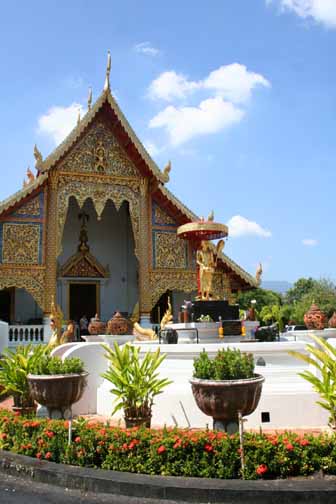
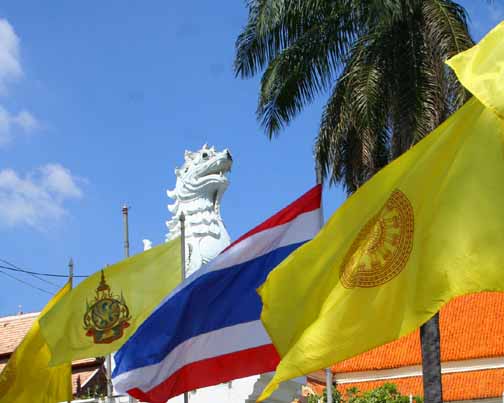
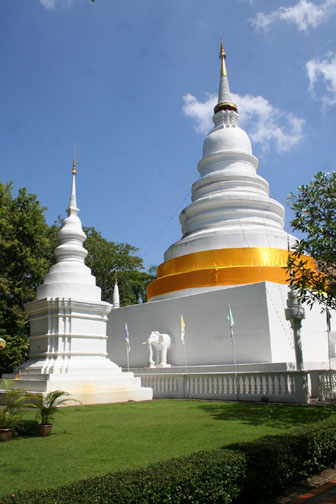
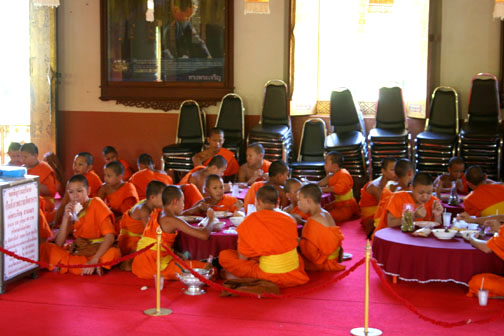
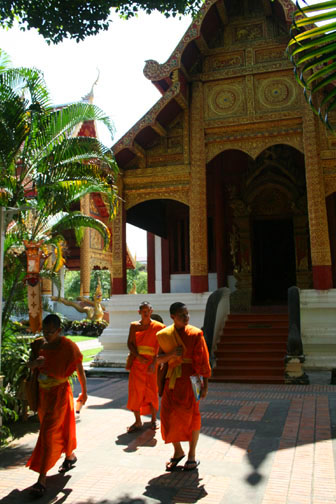
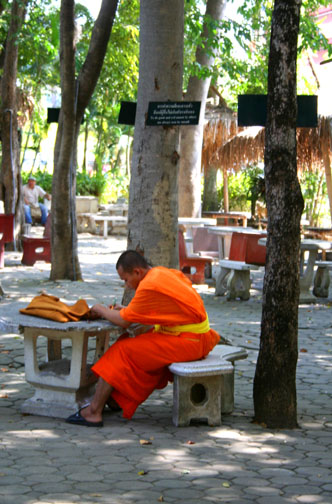

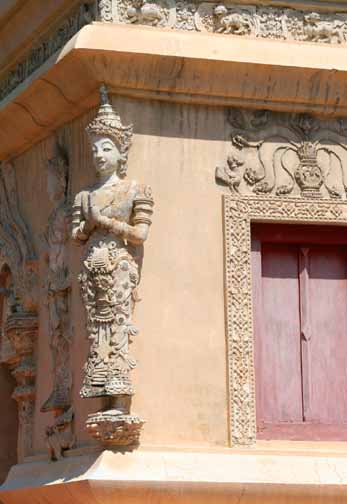
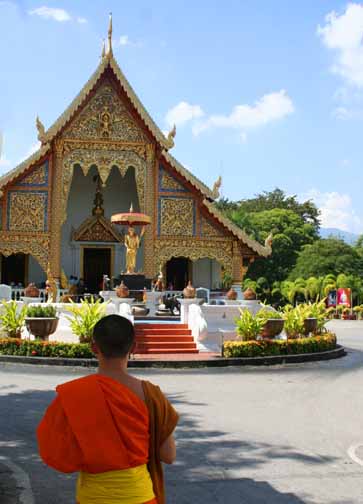


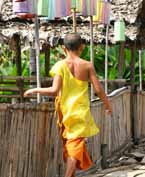
Great article and pictures.
Thanks Jimjj!